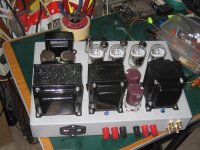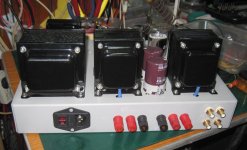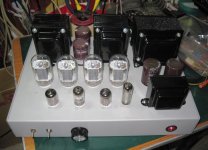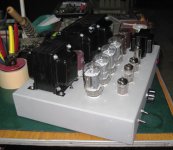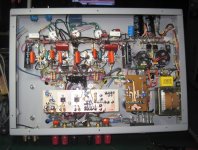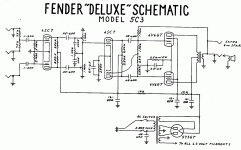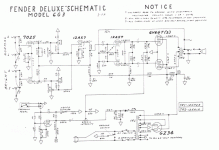I've got a Fender deluxe amp I've build and have all up 470uf of filtering.
Power trafo gives me 300V on SS rectifier so not wanting to drop too much voltage I've opted for:
Choke - 100uf - 100uf - 120uf and 150uf in preamp section. The Voltage drop is only 20V on HT = 280V, amp is quiet and sounds as it should.
The power trafo I use can handle at least double the current so I see no problem overloading it on start. Just asking for an opinion since I don't think it is very common using high capacitance to minimize Voltage drop in tube amps.
Power trafo gives me 300V on SS rectifier so not wanting to drop too much voltage I've opted for:
Choke - 100uf - 100uf - 120uf and 150uf in preamp section. The Voltage drop is only 20V on HT = 280V, amp is quiet and sounds as it should.
The power trafo I use can handle at least double the current so I see no problem overloading it on start. Just asking for an opinion since I don't think it is very common using high capacitance to minimize Voltage drop in tube amps.
Last edited:
Just asking for an opinion since I don't think it is very common using high capacitance to minimize Voltage drop in tube amps.
Well, you put the cart before the horse. You did all the mods before getting the opinions. Did your mods attain the goals you had in mind without creating a problem? How will you measure its performance to decide if all's well? Will opinions make you rest easier? What was wrong with the original circuit you felt wasn't good enough for your playing demands?
I am assuming that this was a build and not a mod, since the word "build" was used, and Fender was not known for using oversized transformers.
My take, If it works to your satisfaction, use it the way it is......If you are concerned with the huge startup surge, install in inrush current limiter like a CL90 in series with the power transformer primary.
Fender used small valued electrolytics because that's what was available in the early days. Little was changed when silicon replaced the tube rectifier, and as always with Fender amps, cost was the main product design criteria.....why use a 250 uF cap when a 47 uF will do.
I have used big value (300-1000 total uF) filter caps in tube amps for years without issue, but these were HiFi amps where a lot of low ESR capacitance is needed to avoid power supply sag on big bass notes and transients. You do have to watch the first cap value if a tube rectifier is used.
In a guitar amp, power supply sag is an important tool to use in defining the amp's "tone." A power supply that drops 20 to 50 volts when the amp is driven 20 dB into clipping will sound different, and sustain longer than the same amp on a "stiff" power supply. This can also be implemented by using a resistor in series with the "power tubes" screen supply, and hanging the entire preamp chain on the screen side of this resistor.
Some of my guitar amps go through an evolutionary period where they are never truly finished. The last one took about a year to finally reach maturity....now there are two more being designed, these will take some time to become something I'll use a lot.
My take, If it works to your satisfaction, use it the way it is......If you are concerned with the huge startup surge, install in inrush current limiter like a CL90 in series with the power transformer primary.
Fender used small valued electrolytics because that's what was available in the early days. Little was changed when silicon replaced the tube rectifier, and as always with Fender amps, cost was the main product design criteria.....why use a 250 uF cap when a 47 uF will do.
I have used big value (300-1000 total uF) filter caps in tube amps for years without issue, but these were HiFi amps where a lot of low ESR capacitance is needed to avoid power supply sag on big bass notes and transients. You do have to watch the first cap value if a tube rectifier is used.
In a guitar amp, power supply sag is an important tool to use in defining the amp's "tone." A power supply that drops 20 to 50 volts when the amp is driven 20 dB into clipping will sound different, and sustain longer than the same amp on a "stiff" power supply. This can also be implemented by using a resistor in series with the "power tubes" screen supply, and hanging the entire preamp chain on the screen side of this resistor.
Some of my guitar amps go through an evolutionary period where they are never truly finished. The last one took about a year to finally reach maturity....now there are two more being designed, these will take some time to become something I'll use a lot.
The HK Citation II that I recently restored for a customer originally used a 200u/200u/250v SS voltage doubler into a 40u 500v main filter.
Original specs were 60/60w/ch., (four KT88's), and the amp is highly favored by audiophiles, even today.
I opted to give the PS a little boost by using a triple 30u 500V can, paralleled for 90u, as well as doubling the seperatly powered bias caps from 20u/20u/150v to a pair of 100u/250v.
The amp's silent as a dead mouse with no signal, B+ sag under heavy use is negligable, and the clipping threshold is increased substantially.
I see no reason to "up" things further.
Original specs were 60/60w/ch., (four KT88's), and the amp is highly favored by audiophiles, even today.
I opted to give the PS a little boost by using a triple 30u 500V can, paralleled for 90u, as well as doubling the seperatly powered bias caps from 20u/20u/150v to a pair of 100u/250v.
The amp's silent as a dead mouse with no signal, B+ sag under heavy use is negligable, and the clipping threshold is increased substantially.
I see no reason to "up" things further.
i used 1000ufd/450vdc ecaps one for each channel in a 6lu8 pp amp i made, i used full wave voltage doubler with 1000ufd/300vdc caps stacked up....i used two chokes, one for the plate supply and another for the screen grid supply...
Attachments
....The input choke reduces your voltage, with the capacitance you have I would skip it,....
Re-rigging from choke-input to cap-input suggests a 1.57X change of voltage, a 2.47X change of power. Something is likely to smoke. Which is what we were trying to avoid.....
Re-rigging from choke-input to cap-input suggests a 1.57X change of voltage, a 2.47X change of power. Something is likely to smoke. Which is what we were trying to avoid.....
Should have did more than a mental calculation. He said he had 280V, 280 x 1.57 = 440V. I used 1.5 x 280 = 420V, which is what the Blackface and Silverface Deluxe Reveb's have on the schematics. I just assumed the amp could be biased up like the later Deluxes and not draw excessive power causing smoke. I should have asked more about the amp, my bad.
Just to clarify, this was originally stereo hifi amp with parallel 6V6 tubes I've build about 15 years ego, than I eventually turned it to a guitar amp. I only kept the power supply as it was including the choke because it was quiet and it wouldn't give me any more Voltage anyway.
Recently I've been changing a cap in the tone stack so that reminded me of the filtering so I thought I ask for opinion. But from replies seems that it's not too unusual than.
One thing that sparked my interest is a mention by Tubelab_com about creating sag by adding resistors to power tubes screens. I don't actually have any as I wanted to get most power I could out of the amp. I just did it like Tweed, that has none too.
But I suspect any sag would be only apparent at high volumes and not at low level playing and probably would lower clean headroom?
Recently I've been changing a cap in the tone stack so that reminded me of the filtering so I thought I ask for opinion. But from replies seems that it's not too unusual than.
One thing that sparked my interest is a mention by Tubelab_com about creating sag by adding resistors to power tubes screens. I don't actually have any as I wanted to get most power I could out of the amp. I just did it like Tweed, that has none too.
But I suspect any sag would be only apparent at high volumes and not at low level playing and probably would lower clean headroom?
Last edited:
Yes, sag would reduce the clean headroom and overall maximum power output.
In the early amps electrolytic caps were small, so that the voltage drop at full volume was substantial. Note that this happens even in a class A amp like the Fender Champ, because once the amp slams into clipping, it is no longer in class A.
The usual guitar amp has several series RC filters which drop voltage from the main B+ to the first input tube. As the amp gets pushed near, and into clipping the main B+ starts to drop. The B+ drop is delayed by the time constants in those RC filters, but the preamp stages will see a slowly dropping supply voltage starting closest to the output stage. This reduces the stage gain, causing a signal compression effect and an increase in distortion. As the note dies out, the reverse will occur, with the gain slowly increasing over several seconds. Together this dynamic compression increases the note's duration, boosting sustain.
Manny variables affect this, and tweaking all of them to get a unique "tone" can take forever.
If you followed a typical Fender schematic, you already did this.
Look at the 5C3 schematic. There is a 10K resistor from main B+ to the 6V6 screens, and another 10K resistor feeding both 6SC7's. The rectifier is a 5Y3 which has quite a bit of internal drop.
Look at the 6G3 schematic. The rectifier is now a 5AR4 which has less drop, and the 10K screen resistor has been reduced to 1 K. There are now two 10K resistors between the screen supply and the input tube, as well as an additional gain stage. This amp will make more power, and have a larger clean headroom, but have a harder "edge" between the onset of compression / distortion and full on clipping.
Some amps known for being clean will use a solid state rectifier (or a tube and SS with a switch) and move the RC chain feeding the preamp to the main B+ supply, since it does not drop as much as the screen supply when the output tubes approach clipping.
In the early amps electrolytic caps were small, so that the voltage drop at full volume was substantial. Note that this happens even in a class A amp like the Fender Champ, because once the amp slams into clipping, it is no longer in class A.
The usual guitar amp has several series RC filters which drop voltage from the main B+ to the first input tube. As the amp gets pushed near, and into clipping the main B+ starts to drop. The B+ drop is delayed by the time constants in those RC filters, but the preamp stages will see a slowly dropping supply voltage starting closest to the output stage. This reduces the stage gain, causing a signal compression effect and an increase in distortion. As the note dies out, the reverse will occur, with the gain slowly increasing over several seconds. Together this dynamic compression increases the note's duration, boosting sustain.
Manny variables affect this, and tweaking all of them to get a unique "tone" can take forever.
Tubelab_com about creating sag by adding resistors to power tubes screens.
If you followed a typical Fender schematic, you already did this.
Look at the 5C3 schematic. There is a 10K resistor from main B+ to the 6V6 screens, and another 10K resistor feeding both 6SC7's. The rectifier is a 5Y3 which has quite a bit of internal drop.
Look at the 6G3 schematic. The rectifier is now a 5AR4 which has less drop, and the 10K screen resistor has been reduced to 1 K. There are now two 10K resistors between the screen supply and the input tube, as well as an additional gain stage. This amp will make more power, and have a larger clean headroom, but have a harder "edge" between the onset of compression / distortion and full on clipping.
Some amps known for being clean will use a solid state rectifier (or a tube and SS with a switch) and move the RC chain feeding the preamp to the main B+ supply, since it does not drop as much as the screen supply when the output tubes approach clipping.
Attachments
a LOT of the 'magic" of those old Fender amps is indeed the sag compression.
Using an OPT that's too small for the job also adds to the Fender "tone." A fat note on the 6th string pushes the OPT into saturation further driving up the tube current and dragging down the B+.
In the 60's there was this old wives' tale, "Never play bass through a Bandmaster." A friend liked the distorted bright sound he got, and did it anyway. It took about a year, but fortunately only cost him a 6L6GC. Likewise, stuffing a 6L6GC into a Tweed Champ made for a "different" sound, and a dead power transformer, after about a year.
What you do with your amp depends largely on what you like, what, and how you play. There are plenty of players that prefer a stiff power supply that doesn't sag.
I've seen plenty of websites with musicians discuss their amps......
Guitar players, musicians in general, should stick to playing music...... period.
And stop playing wannabe tech/modifier of electronics.
Focus on making music....
Leave the electronic technical stuff to people who know it.
Guitar players, musicians in general, should stick to playing music...... period.
And stop playing wannabe tech/modifier of electronics.
Focus on making music....
Leave the electronic technical stuff to people who know it.
- Status
- This old topic is closed. If you want to reopen this topic, contact a moderator using the "Report Post" button.
- Home
- Live Sound
- Instruments and Amps
- Excessive filtering?
